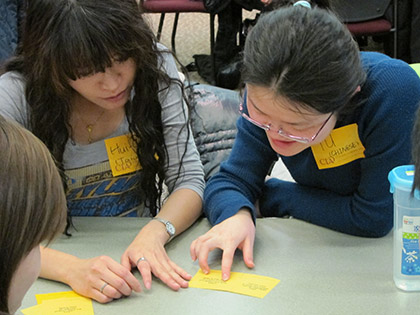The TandemPlus cultural and conversation exchange program offers University of Minnesota students and community members the opportunity to use their second language skills with native speakers of the languages that they are learning. TandemPlus has different facets, including the Face-to-Face (F2F) Exchanges and the Class-to-Class (C2C) Exchanges.
The most popular facet is the F2F program, in which individual students voluntarily enroll because they want to improve their second-language skills. After registering on-line and being matched by Tandem staff based on their personal and linguistic preferences, participants meet with one another in person on or around campus on a regular basis. These partnerships often grow into strong friendships. U of M student Sean Nelson, who participated in a Japanese-English F2F exchange during the Spring 2013 semester, stated,
Tandem has helped more than I would have ever imagined. I initially didn't know what I'd gain from a Tandem partner, but it has become such an amazing experience. I have become very comfortable with speaking Japanese, my listening comprehension has improved tremendously and my cultural understanding has improved greatly.
According to Nelson, his F2F partnership has also increased his vocabulary, helped him improve his performance in class, and more:
Along with all that, I've gained an amazing friend. I've gained experiences and information I don't feel I would have ever been taught in class. It has also helped prepare me for studying abroad this summer. And finally, it has connected me to the Japanese community at the University. Without my Tandem partner, I would have never thought about signing up to join the board of the Japanese Student Association, where I am now an officer and love every second of it.

While the F2F program is individual and voluntary, the C2C program is done in conjunction with a language class at the University. In it, students are paired with a partner in a complementary language class abroad -- for example, students in a Spanish class at the U of M could be paired with students in an English class in Spain. Students communicate with each other in their first and second languages, using Skype or another on-line medium, and learn about different cultures while utilizing their language skills. Rick Treece is a French instructor at the U of M whose students have participated in C2C exchanges for several semesters. According to Treece, the program offers some great incentives for U of M students:
I liked the idea of giving my students authentic contact with native speakers their own age. The experience would be motivational from two standpoints: showing them how much they can really achieve in French already, and showing them what they need to work on in order to be more successful. The chances for cross-cultural insights (which is a big element of our French 1004 curriculum) was also attractive.Treece pointed out that the opportunity did not come without challenges:
The mismatch of the academic calendars is a hassle. When we're putting together our Fall syllabus, the French are on vacation; they're not at work answering their emails, and even when they do reply, they don't know their enrollments or perhaps even their course assignments yet. The delay between the start of our Spring semesters is even worse, so that we end up with only about 5 weeks of course-time in common in the Spring, once you take out Spring Breaks, etc. The solution is just that we've learned to be flexible, to plan based on expectations, and then adjust in midstream.
Despite the challenges that came with the program, the benefits far outweighed the cost, according to Treece. He noted that while a "handful of students found it frustrating, even negative," the majority of his students had "pleasant and cordial" exchanges, and that some even had "life-changing experiences," such as the opportunity to visit their partner overseas.
All in all, TandemPlus is a free program that offers the potential for increased linguistic fluency, greater cultural awareness, or even a life-changing experience. The F2F program operates during all semesters of the academic year, including Summer, while the C2C program operates mainly during the academic year. Students or instructors who want to learn how to participate in these exchanges should get in touch with TandemPlus at tandem@umn.edu.

No comments:
Post a Comment
Note: Only a member of this blog may post a comment.